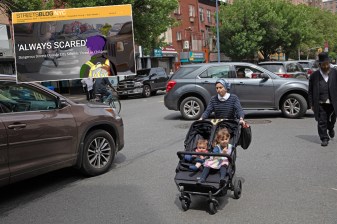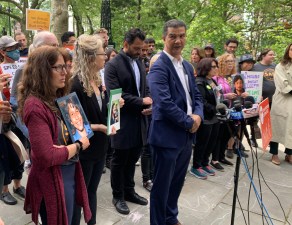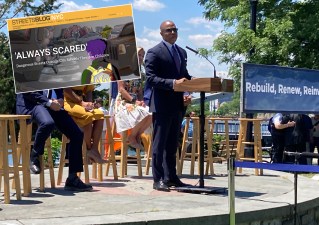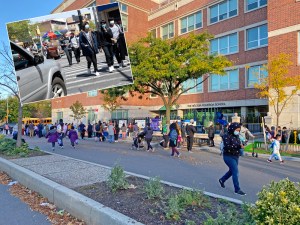After Streetsblog Probe of Dangerous School Streets, DOT Talks Up Student Safety Projects
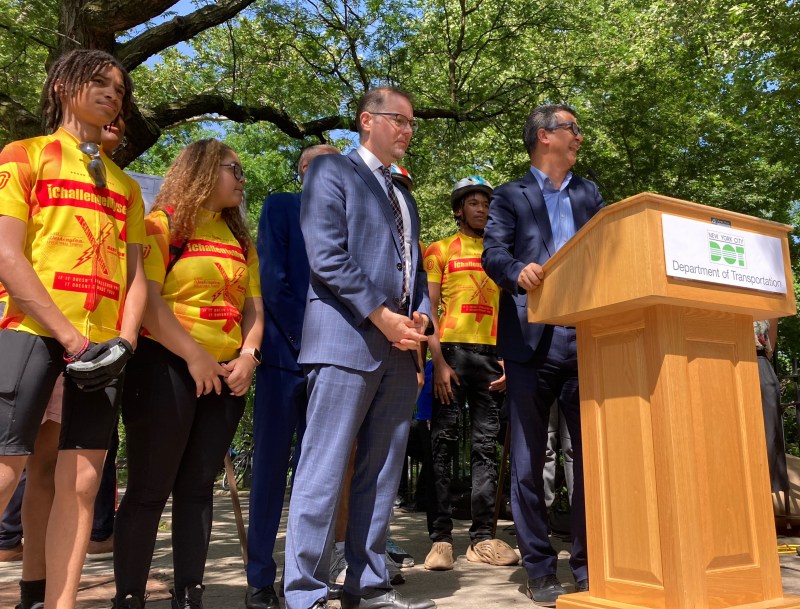
Lesson learned.

Weeks after Streetsblog revealed high rates of traffic violence near city schools, especially schools with majority students of color, the city announced Wednesday it will redesign dozens of school streets this year, some in historically underserved communities.
“Our children and families deserve to be able to walk to school without the fear of being struck by a speeding or reckless driving,” Department of Transportation Commissioner Ydanis Rodriguez said at a press conference in upper Manhattan.
The school street upgrades are among 100 road safety projects DOT expects to complete this year, most in dense neighborhoods of color with a history of lackluster city investment, officials said.
At the event, Rodriguez highlighted several school street safety projects in the works and touted the contributions of the “I Challenge Myself” school program, whose students collaborated with DOT on safety upgrades outside seven schools near Amsterdam Avenue and W. 190th Street.
Rodriguez also made clear that addressing the previous administration’s failure to keep kids safe around their schools is a priority of the Adams administration.

Rodriguez made similar comments two weeks ago. Then, as on Wednesday, he did not dismiss the idea of taking more aggressive measures to keep children safe outside schools — like restricting vehicular traffic on school streets — but he stopped well short of calling for a major expansion of the city’s school streets program.
“We are working to re-imagine the use of more streets so that we can translate those into open streets, open restaurants, getting more safety around the schools. So we are working on that,” he said. “We have only been here five months … but to continue improving safety around the school is a top priority for Mayor Adams and for me as a commissioner.”
Advocates say the best way to keep kids safe outside schools is simply to close school streets to cars. That’s a technique used by cities around the world, but rarely in New York City, where only a few dozen of the city’s thousands of schools are on streets closed to traffic during school days.
Rodriguez on Wednesday did little to clarify his comments two weeks ago that his agency has a “whole plan to create safe routes to school, which is a whole new idea that we had that we’re going to be working on.”
When asked about those comments, Rodriguez said: “We are identifying areas [that have] many schools in certain corridors to be able to put any safe tool that we have for those students to know that it is safe for them to walk.” He also mentioned the nearly $1 billion in new budget money over five years for street safety projects that Mayor Adams announced earlier this year.
It’s unclear what tools Rodriguez was evoking. The city has not provided a list of the 100 street improvement projects to be finished by the end of this year, and DOT Spokesman Vin Barone did not provide the number of those projects that are near schools.
The Streetsblog investigation revealed how little the city has done systematically to keep kids safe around schools, typically enacting only modest safety improvements on dangerous school streets and allowing a shortage of school crossing guards to persist for years.
To measure the impact of more aggressive school street safety measures, Streetsblog on Wednesday compared crash and injury rates around five schools that have closed neighboring streets to cars (map) and found a dramatic decreases in the danger posed by cars on those blocks.
The schools studied were Grace Church School on E. 10th Street in Manhattan; PS 6 on E. 81st Street in Manhattan; Marymount School Of New York on E. 82nd Street in Manhattan; Futures Ignite on W. 182nd Street in Manhattan; and IS 61 in Queens.
From January through May of 2018, when the school streets were open to car traffic, there were 18 reported crashes on school days. From January through May of 2022, after the streets were closed to cars, there was only one crash, a decline of 94 percent. Crashes with injuries dropped from six to zero.
These numbers, while small, build on previous findings by Streetsblog that streets become safer where the city reduces car travel. On the 34th Avenue open street in Jackson Heights, for example, crashes dropped by 78 percent in the hours when the barricades are out. A follow-up investigation revealed similar declines in crashes.
